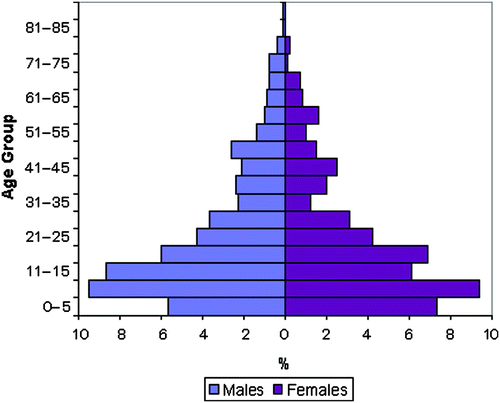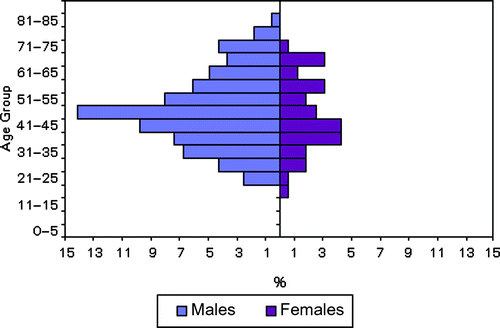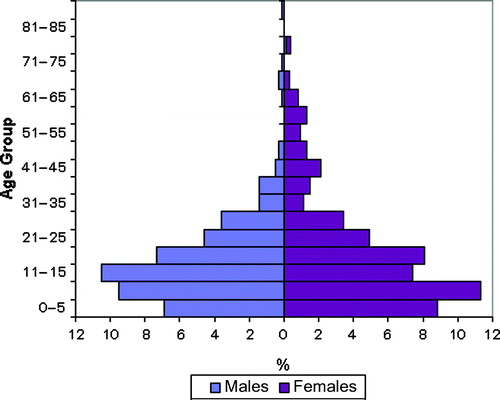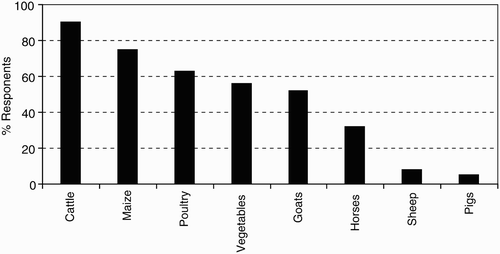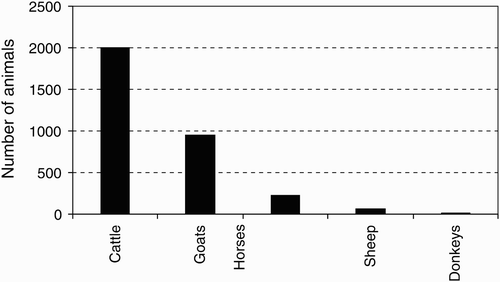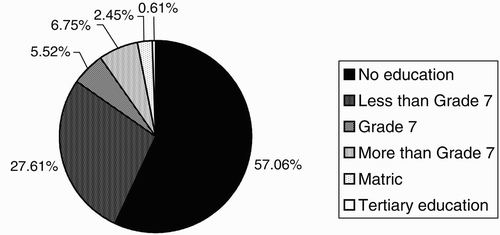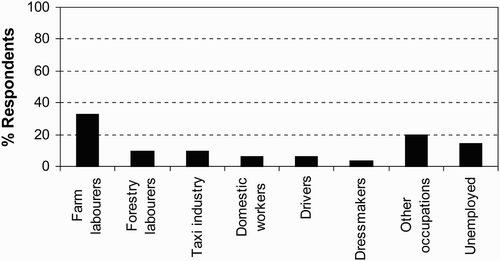Abstract
The Land Reform Programme in South Africa aims to transfer 30% of white-owned commercial land to African owners before 2015. The Department of Land Affairs needs to ensure that land redistribution projects are viable and sustainable before approval. This article reports on a case study conducted in the Ermelo district of Mpumalanga Province, South Africa, investigating the situation with regard to the Ekaluka Farmers' Association. The expectations, structure and composition, level of education and employment status of all 163 members of the Association were ascertained through structured interviews. The results indicate various factors that could prove valuable in the process of determining the potential success of this proposed land redistribution project.
1. Introduction
Since 1913 at least seven million South Africans have been uprooted or resettled as a result of political pressures and other factors (De Wet, Citation1994). To correct the imbalances of the past, in 1994 the South African Government initiated the Land Reform Programme (LRP), which is administered by the Department of Land Affairs (DoLA). The programme has three components: land redistribution (involving the transfer of white-owned commercial farmland or state land to disadvantaged South Africans), land restitution (restoring land to those dispossessed of their land and their rights to land) and land tenure reform (transforming the way land may actually be owned). This study focused on the land redistribution component of the LRP. Land redistribution places the onus on individuals, groups or communities to take the initiative, requiring them to indicate a targeted piece of land or the type of land they are seeking. They then approach the DoLA for grants to purchase the identified land. Once approved, the grants may be pooled (DoLA, Citation1997).
The DoLA will only approve the allocation of such grants once they have clarity that the purchase will meet the community's expectations, and when the factors that could lead to the successful implementation of agricultural projects are in place. Various studies indicate that the success of such a project depends largely on the structure and the composition of the community involved, as well as on other variables such as the level of education and employment status of the participants (Botha & Lombard, Citation1992; Kinsey & Binswanger, Citation1993; Van Rooyen & Njobe-Mbuli, Citation1996; Turner, Citation1997; Hall, Citation2007). If the communities' expectations are not met through the allocation of land grants, this may lead to disillusionment and the failure of the land redistribution programme. Equally important is to collect information from the community – its structure and composition, level of education and employment status – to gauge whether the project has been successfully implemented.
The Ekaluka Farmers' Association (EFA) is an example of a community involved in the land redistribution process. Its members have applied for Settlement and Land Acquisition Grants (SLAGs) to purchase a farm near Driefontein in the Ermelo District of Mpumalanga. The purpose of this study was to find out what the EFA members expected and how likely agricultural projects were to succeed if the SLAGs were allocated to the community. Structured interviews were conducted with all 163 members of the EFA in 2002. This article provides evidence that ‘poor’ rural communities have valuable resources that could help ensure the success of the land redistribution programme.
2. The land redistribution programme in South Africa
The African National Congress (ANC) committed itself to land reform before it came into power in South Africa's first democratic elections in 1994. In the party's election manifesto the Reconstruction and Development Programme stated that land reform was to redress the injustices of forced removals and denial of access to land. This commitment to land reform is further enshrined in the 1996 Constitution of South Africa, which states that ‘South Africa belongs to all who live in it, united in diversity’ and resolves to ‘heal the divisions of the past and establish a society based on democratic values, social justice and fundamental human rights’ (Republic of South Africa [RSA], 1996:1). In the Bill of Rights contained in the Constitution, the South African Government commits itself to ensuring equitable access to land, providing tenure security or comparable redress, and restoring land to people who have been displaced owing to racial discrimination since 19 June 1913 (RSA, Citation1996). To fulfil these commitments, the government set up the LRP as outlined in the White Paper on South African Land Policy (DoLA, Citation1997). As stated above, the programme has three components: land redistribution, land restitution and land tenure reform and this study focuses on redistribution.
The South African Government's land redistribution policy, as set out in the White Paper, states that:
The purpose of the land redistribution programme is to provide the poor with access to land for residential and productive uses, in order to improve their income and quality of life. The programme aims to assist the poor, labour tenants, farm workers, women, as well as emergent farmers. Redistributive land reform will be largely based on willing-buyer willing-seller arrangements. Government will assist in the purchase of land, but will in general not be the buyer or owner. Rather it will make land acquisition grants available and will support and finance the required planning process. In many cases, communities are expected to pool their resources to negotiate, buy and jointly hold land under a formal title deed. Opportunities are also offered for individuals to access the grant for land acquisition. (DoLA, Citation1997:38)
The redistribution started with a pilot programme in the form of the SLAGs, which ran from 1995 until 1999. The pilot programme aimed to benefit poor households, who could initially apply for state grants of R15 000 (later raised to R16 000) per household to enable them to buy land, for settlement or for agriculture, or both. Only households earning below R1500 a month were eligible for these grants. However, South Africa's restrictions on subdivision caused problems for the programme. Because the land market did not have any R15 000 (later R16 000) plots on offer, beneficiaries were obliged to pool their grants in order to purchase farms. In many instances large groups were formed with the sole purpose of meeting the required farm price. This became known as the ‘rent-a-crowd’ phenomenon (Turner, Citation1997; Van den Brink et al., Citation2007).
According to Kepe & Cousins (Citation2002), 60000 commercial farmers own 82 million hectares, which accounts for 67% of the total area of South Africa. The LRP aimed to redistribute 30% of South Africa's agricultural land and complete the adjudication of land claims by 1999, i.e. within five years (ANC, Citation1994). By 1999, however, less than 1% of agricultural land had been transferred through all aspects of land reform. The slow progress of land reform resulted in a ministerial review being convened in 2000, which led to a revised and no doubt more realistic target of transferring 30% over an extended time frame of a further 15 years by 2015. During this review SLAG operations were suspended at the end of 2000, pending the outcome of the review. The review concluded that (i) the limited involvement of the Department of Agriculture (DoA) before, during and after project approval had severely compromised the success of those redistribution projects aimed at supporting agricultural production, (ii) projects undertaken by large groups (e.g. over 25 households) had a high failure rate in terms of income generation, (iii) the lack of an own contribution made it difficult to screen applicants, and (iv) the means test restricted the target group unduly – emerging commercial farmers could not qualify (Van den Brink et al., Citation2007). The ministerial review also led to the introduction of a new programme for land redistribution in addition to SLAGs, namely the Land Redistribution and Agricultural Development (LRAD) programme.
The LRAD programme was launched in 2001 with the goal of establishing a class of African commercial farmers and since then has emerged as the primary means by which people are able to acquire land. It is a joint programme of the DoLA and the National Department of Agriculture, thereby more closely linking land acquisition to support for new farmers (Ministry of Agriculture and Land Affairs [MoALA], Citation2001; DoA, Citation2001b). It differs from SLAGs mainly in the broadening of the target group to include emerging African commercial farmers and the decentralisation of project approvals to the provincial level. One mechanism used to achieve this was the ‘sliding scale’ grant, which made higher grants available to beneficiaries, depending on the size of their own contribution. This own contribution consists of own labour (‘sweat equity’), cash and assets to be used for the project, or a combination of at least two of these. The lowest grant, set at R20000 per individual, is made available against an own contribution of R5000. The highest grant, amounting to R100000, is made available to beneficiaries who have contributed R400000. Both the SLAGs and the LRAD experienced a slow start, as systems developed and officials gained familiarity with the implementation procedures. However, both programmes also showed they could accelerate rapidly in subsequent years (Van den Brink et al., Citation2007). The LRAD is intended for agricultural land use only and gives priority to commercial farming. As an alternative funding programme for those who are not in a position to invest in or risk commercial farming, or would like to purchase land for residential or other non-agricultural purposes, SLAGs are also still available as a land redistribution mechanism, but are used less often, since the LRAD offers more money. Once the members of the community have been awarded the SLAGs, nothing prevents them from applying for a LRAD grant as well (DoLA, Citation2001a; DoA, Citation2001a,b).
Since the LRAD programme places increased emphasis on commercial agricultural production, it ensures that most LRAD funding goes to large-scale projects involving relatively small groups of better-off applicants, and is thus not helpful to smaller applicants who have difficulty raising own contributions and preparing business plans. It may increase the viability of projects in terms of commercial production, but it does little to address the wider needs of poverty reduction, job creation and household food security – hence the need to keep SLAGs available, should they be requested. The present study investigated a community in the process of applying for SLAGs in order to purchase land in Mpumalanga Province after the LRAD was implemented in 2001.
In Mpumalanga, land reform faces many challenges. In terms of land restitution, 5146 land claims were lodged by the cut-off date of December 1998 and, according to De Villiers (Citation2003), only 558 had been settled by 31 December 2002. However, the Land Claims Commissioner announced on 5 February 2009 that more than 90% of these land claims had been settled and only 738 were outstanding, which is very encouraging for land restitution. In the meantime, the aim of redistributing 30% of land to previously disadvantaged people is facing a much greater challenge. According to Webb (Citation2006), only 200000 hectares of land had been delivered in Mpumalanga since 1994, and since Mpumalanga has about five and a half million hectares of agricultural land, this implies that it has taken 13 years to redistribute 3.6% of the agricultural land in this province – which makes the target 30% redistribution by 2015 appear impossible to achieve. As a further challenge, Kariuki & Van der Walt (Citation2000) state that research in Mpumalanga shows that government has provided no real post-transfer support for resettled farming communities. These challenges make it imperative for communities such as the EFA to look within themselves to make land redistribution successful.
3. Background to the community
Most members of the EFA live in the Driefontein area – referred to by the community as a ‘black spot’ because the apartheid government used it as a ‘collection point’ or ‘dumping ground’ for people dispossessed of their land, or for farm workers forcibly removed from white-owned farms. The structure and composition of the EFA is discussed in Section 5 below, as well as other factors that could help the land redistribution project succeed.
4. Methodology
This case study was based on the interpretive paradigm, in which the research does not concern itself with the search for laws or rules but rather ‘seeks to produce descriptive analyses that emphasise deep, interpretive understanding of social phenomena’ (Henning, Citation2004:21) – the phenomenon in this instance being land redistribution. Interviews were conducted with all 163 members of the EFA. These were structured one-on-one interviews, to increase the response rate, i.e. so that it would be possible to interview all the EFA members, and to ensure standardised responses. As far as possible all interviews were conducted in English or Afrikaans. As most of the Ekaluka community are isiZulu first language speakers, a Zulu interpreter (who was not a member of the community) was used to clarify certain questions and terminology where necessary. However, many community members had a good command of the Afrikaans language, probably because many had been employed on farms and forestry plantations in the past, where Afrikaans used to be the most commonly spoken language.
5. Results and discussion
5.1 Community demographics
This section describes the demographics of the broader Ekaluka community and the EFA members, the respondents, using age–sex distribution figures.
5.1.1 Age–sex distribution of the Ekaluka community
At the time of the study, 2002, the Ekaluka community (both respondents and dependants) consisted of a total of 961 people. This population is broken down into sex and age groups in . The table shows that the population is relatively young, with 45.1% being below the age of 15. Adults account for 51.0%, while only 3.9% are over the age of 65. shows the age–sex distribution of this community: a growing population with a large percentage of young children. Also evident in is the considerable number of young adults (20 to 45 years) missing from the population pyramid. This may be as a result of migrant labour, although the cause was not specifically determined by this study.
Table 1: Age–sex distribution of the Ekaluka community (respondents and dependants)
5.1.2 Age–sex distribution of respondents
The EFA members were aged from 20 to 85 years. The age–sex distribution in shows that nearly 75% of the respondents were male. This unequal gender distribution may be because most households are male-headed, and as a result males were listed as the applicant (only one person per household may receive a SLAG). It was encouraging to note that female members of the community took an active part in meetings and debates on a community level.
The age of the EFA members may play an important role in the success of the project. Botha & Lombard (Citation1992) and Van Rooyen & Njobe-Mbuli (Citation1996) state that adults aged between 30 and 45 have the best chance of success in land reform projects. When SLAG applicants are either too young or too old, this can have a detrimental effect on the project. The fact that 34.4% of the respondents in this case study were in the 30 to 45 age group could therefore be advantageous to the project. Of concern, however, is that 55.8% of the respondents were over 45, and 9.9% were below 30. The success of the project might therefore depend quite heavily on the ability of the respondents younger than 30 and older than 45 to access family labour in the family unit, which in this case is the extended family.
5.1.3 Age–sex distribution of dependants
The number of dependants in the Ekaluka community provides an indication of the number of people who were likely to benefit from this land redistribution project, and how large a supply of labour there is in the area. The agricultural and economic performance of a household is positively correlated with the number of family members who are able to work (Kinsey & Binswanger, Citation1993). Younger respondents are less likely to have access to family labour. These respondents will have children of school-going age (or younger) and will rarely exercise authority over other members of the extended family or household. The success of the project may depend on the ability of the respondents to work in and manage the farming unit.
Dependants may be viewed in two ways: first, as the economically unproductive portion of a population, consisting of those younger than 16 and older than 65 (Fellman et al., Citation1999), and second as those who are dependent on the respondents for a means of livelihood. The dependency measure in this study therefore included all community members aged below 16 and above 65, as well as some between 16 and 65 years, regardless of whether they could make a productive contribution to a farming enterprise.
The first indicator of dependency is defined as the dependency ratio, which is ‘a simple measure of the number of dependants, old and young (usually below 15 and above 65) that must be supported by people in their productive years (aged between 16 and 65)’ (Fellman et al., Citation1999). According to this ratio, every economically active person supports 0.96 dependants. Therefore every economically active person in the community can be seen as supporting one dependant.
The second indicator of dependency relates to the number of people who are dependent on the respondents for their livelihood. The 163 respondents listed a total of 798 dependants (age–sex distribution shown in ). This translates into a ratio of 1:4.9, meaning that every applicant has 4.9 dependants, considerably higher than the 1:0.96 indicated by Fellman et al. The dependency ratio of all the projects that were granted SLAGs in 1999 was 1:4.5 (no details of the method of calculation were provided) (DoLA, Citation2001b). This second way of calculating the dependency ratio is more accurate than the first. The Ekaluka community therefore has a higher than average dependency ratio (when compared to the dependency ratio of the projects that received SLAGs in 1999), which indicates that a large number of people will possibly benefit from this land redistribution project. The dependency ratio also indicates the need that this community has for land, since the larger the number of dependants in a family unit, the greater the need for land (Kirsten et al., Citation1994). The large number of dependants becomes evident when comparing (EFA members) with (dependants). The slightly higher number of female dependants may be because most of the EFA members are male.
5.2 Community expectations
To ensure that the SLAGs would indeed meet the community's expectations, it was necessary to find out what these expectations were: first, the land use they envisaged, and second the type of agricultural activity they intended to practise on the land if the SLAGs were approved.
5.2.1 Envisaged land use
When asked to indicate more than one land use option for the identified land, 95.7% of the EFA members chose ‘for settlement’ (see ). A high value was placed on having the title deed or document indicating ownership. There was some bias here, as this group had been formed in order to achieve their goal of accessing land. Grazing land for livestock was another strongly identified need (chosen by 89.57% of the respondents). In the immediate vicinity of Driefontein there was a high level of competition for the available grazing land. This was confirmed by some of the members of the community, who admitting to cutting fences at night on neighbouring farms and forestry areas, and allowing their livestock to graze illegally. The livestock were then removed at dawn. Cultural importance is attached to owning livestock, as the members of the Ekaluka community see the animals as a symbol of status and wealth. The other important land use identified was for growing crops, mainly dryland maize (78.53% of respondents).
5.2.2 Type of agriculture
The respondents indicated a high degree of interest in farming with livestock (see ), and cultivating maize and vegetables was also seen as important. They mentioned a range of livestock, with a high level of interest in cattle (90.2% of the total of 163 respondents), as many of them had extensive experience of this type of farming. Cattle were by far the most important factor mentioned in interviews. Although many respondents did not own cattle, the majority wanted to practise cattle farming. Cattle play an important social and financial role in South African black rural communities, being valuable as insurance against hard times, for bride wealth payments, loaning of animals, cooperative ploughing, meat and milk sharing, and hiring out and selling of goods and services (Shackleton et al., Citation2001). Respondents also expressed interest in farming goats (52.2% of respondents), viewed by the community as ‘the poor man's cattle’. In many areas of Africa today, goats have taken over the traditional role of cattle, because they are able to survive in harsher conditions than cattle. An interest was also expressed in breeding horses (31.9% of respondents), an important mode of transport in the area. A preference for maize farming was also indicated by 74.8% of the respondents. Maize is cultivated during the rainy season (summer), for both human consumption and animal feed. Most of the small-scale farming activities undertaken by the Ekaluka Community in the area are conducted on a subsistence basis and used to supplement other incomes. For this reason many people plant vegetables and keep chickens, ducks, geese and turkeys. As a result a high level of interest was shown in poultry farming and vegetable production (62.6% and 55.8% of respondents, respectively).
5.2.3 Livestock ownership
The 163 EFA members collectively owned 2000 head of cattle, 950 goats, 220 horses, 60 sheep and nine donkeys (see ). These surprisingly large numbers have both positive and negative implications for the success of the project. On the positive side, since the community already has plenty of livestock it will have to make only a limited investment should it opt for this type of farming; on the negative, there could be concerns about the carrying capacity of the identified land.
5.3 Education levels
Various studies indicate that the higher the level of education of an individual or community, the better the farming performance (Everson, Citation1989; Botha & Lombard, Citation1992; Kinsey & Binswanger, Citation1993). The level of education may therefore be an important contributing factor to the success of a project.
The level can be measured as either formal or informal: ‘formal’ meaning school education, and ‘informal’ meaning skills or competencies that are not necessarily learned in a classroom. The respondents' level of formal education was low (see ), with 57.1% having no education and 27.6% having less than Grade 7. Only 15.3% had Grade 7 or higher. This figure was made up of 5.5% with Grade 7, 6.8% higher than Grade 7, 2.5% with matriculation certificates (Grade 12), and 0.6% with tertiary education (consisting of a teaching diploma). Therefore 84.7% of the respondents had either no education or only a basic education, while 9.2% had secondary education and 0.6% tertiary education. This generally low level of formal education can be ascribed to the rural nature of the study area and historical and political factors.
When it came to informal education, a number of respondents had completed courses in fields such as plastering, bricklaying, plumbing, sewing, painting, dressmaking, child care and building. One respondent held a certificate in agriculture, and the current chairperson of the EFA had completed courses in rural development, community development and project supervision. Many of the respondents had gained extensive farming experience under their previous employers, relating to various aspects of farm management. Although the majority of respondents did not have high levels of formal education, it is important to note that many of them had valuable and wide-ranging experience that could contribute to the success of the project.
5.4 Employment status
At the time of the research, 31.9% of the respondents were employed as farm labourers; 9.2% worked in the forestry industry on the various plantations in the region, 9.2% were involved in the taxi industry, either as taxi drivers, or owners, working principally in the Gauteng region; 6.1% were drivers for farmers, forestry or other industries in the area; and 14.1% were unemployed. Female respondents worked as domestic workers (6.1%) on neighbouring farms or as dressmakers (3.7%). A further 19.6% of the respondents were employed in a wide variety of occupations. These ‘other occupations’ included the following categories: teachers, inyangas (traditional healers), security guards, self-employed persons, clerks, factory workers, mat makers, broom makers, miners, builders, painters, bricklayers, shopkeepers, carpenters, plumbers and wood vendors. These skills could make a valuable contribution to the success of the project (see ).
Family incomes were supplemented by various informal activities such as selling wood, chickens, brooms and clothing. In addition, old-age government pensions served to support a number of families. A large portion of the employed people were involved in unskilled labour. They also ran informal businesses, including buying and selling skills and foodstuffs at the roadside or from ‘tuckshops’. Business activities in the informal sector supplemented household incomes. The employment status of the respondents provided an overall idea of all the skills and fields of experience that might guarantee success for the community, should the SLAGs be approved.
5.5 Additional measure of success
Important observations were made by the author when attending the various community meetings and site visits to the area. The most important factor identified through observations related to community cohesion. It was apparent that the members of the EFA attended all the community meetings diligently and regularly, and that they had a strong community spirit and were dedicated to their objective of accessing land for agriculture. These factors all lead to a high level of community cohesion.
6. Analysis of results
The study revealed that the respondents had a strong preference for cattle and associated livestock farming activities. These activities will have to be carefully managed in order to facilitate a sustainable farming enterprise – especially keeping in mind the carrying capacity of the land. This type of agricultural activity will have to be investigated during further studies on the viability of the Ekaluka project. The specific land redistribution project stands to benefit 961 people. The success of the project, should it be approved, will depend on the respondents' ability to manage a large-scale agricultural venture while providing significant benefits to all the members of the wider Ekaluka community. The respondents' informal educational levels and employment status will make a valuable contribution towards the future success of this project.
Flexibility should be built into the planning process of land reform projects, as records show that where strict guidelines are imposed on communities, whether in terms of tenure type, cropping patterns, management or marketing structures, projects tend to develop economic and social problems (De Wet, Citation1994). Although detailed planning will be more appropriate after an investigation into the expectations of the community has been conducted, it is important to be flexible at the start.
Jacobs et al. observe that ‘intergovernmental coordination, particularly between the Department of Land Affairs and the various departments of agriculture, remains a critical weakness in the redistribution programme, particularly in the post-transfer support’ (2003:25). The DoLA, together with the DoA, will have to expand its extension services to ensure that the projects approved for the purchase of commercial farmland have the needed support to ensure the profitability and viability of land redistribution projects.
The need for intergovernmental collaboration is acknowledged by the new Ministry of Rural Development and Land Reform, which was established by President Jacob Zuma on 11 May 2009. This Ministry combines the functions of the old Ministry of Land Affairs with the new function of Rural Development. The Ministry of Rural Development and Land Reform has proposed a new strategy, the Comprehensive Rural Development Programme (CRDP), for fighting poverty, hunger, unemployment and underdevelopment in rural areas. This strategy aims to provide a more comprehensive and integrated approach to rural development, which includes land redistribution projects. The Ekaluka community has been identified as part of a pilot site for the implementation of the CRDP (Department of Rural Development & Land Reform [DoRD & LR], Citation2009).
7. Conclusion
This study of the EFA provided insights into the characteristics of communities that should be taken into consideration before SLAGs are allocated. The land use and type of agriculture the EFA envisages for the identified land must be taken into consideration in further planning. This study is only a portion of the land redistribution process before a community can be allocated SLAGs for the purchase of land. The next step in the approval procedure is to investigate economic viability and feasibility, which includes a start-up business plan for the specific project. Only once this process has been completed and the project is seen as viable can the SLAGs will be approved, and the land transferred to the EFA.
The South African Government's original target of redistributing 30% of commercial farmland in South Africa by 1999 has been extended to 2015 as a result of slow progress: ‘Only about 3% of commercial farmland has been redistributed between 1994 and 2004’ (Kepe & Cousins, Citation2002). The government will have to allocate a greater portion of its human, technical and financial resources to land redistribution if it wishes to achieve this goal.Footnote1
Notes
1Since the collection of the data for this study, the EFA has gained approval to receive their SLAGs. The EFA have pooled their SLAGs and purchased three portions of the farm Kransbank HT (15/R, 15/1 and 15/2) comprising a total of 1984 hectares in the Pixley Ka Seme Local Municipality. These three properties are registered under the name ‘Ekaluka Communal Property Association’.
References
- ANC (African National Congress) . 1994 . Reconstruction and Development Programme: A Policy Framework , Johannesburg : African National Congress .
- Botha , C AJ and Lombard , P P . 1992 . “ The effects of education and training on the managerial attributes of project farmers in the KaNgwane homeland of South Africa ” . In Proceedings of the IAAE Inter-conference Symposium, 4–7 July , Namibia : Swakopmund .
- De Villiers , B . 2003 . Land Reform: Issues and Challenges , Johannesburg : KAS (Konrad-Adenauer-Stiftung) .
- De Wet , C . 1994 . Resettlement and land reform in South Africa . Review of African Political Economy , 21 ( 61 ) : 359 – 73 .
- DoA (Department of Agriculture) . 2001a . Land Redistribution for Agricultural Development , Pretoria : Department of Agriculture . www.nda.agric.za/docs/redistribution.htm Accessed 12 February 2007
- DoA (Department of Agriculture) . 2001b . Land Redistribution for Agricultural Development: A Sub-programme of the Land Redistribution Programme , Pretoria : Department of Agriculture . http://land.pwv.gov.za/redistribution/lrad.htm Accessed 12 February 2007
- DoLA (Department of Land Affairs) . 1997 . White Paper on South African Land Policy , Pretoria : Government Printer .
- DoLA (Department of Land Affairs) . 2001a . Land Redistribution for Agricultural Development (LRAD) , Pretoria : Government Printer .
- DoLA (Department of Land Affairs) . 2001b . The significance of allowing individuals to access the grant in addition to households , Pretoria : Department of Land Affairs . http://land.pwv.gov.za/redistribution//individual%20versus%20household.html Accessed 20 May 2006
- DoRD & LR (Department of Rural Development & Land Reform) . 2009 . “ Comprehensive Rural Development Programme (CRDP). Status Quo Report ” . In Mkhondo and Pixley Ka Seme Local Municipalities Pilot (Donkerhoek, Kwangema, Emahhashini) , Pretoria : Government Printer .
- Everson , R E . 1989 . “ Human capital and agricultural productivity change ” . In Proceedings of the 20th International Conference of Agricultural Economists, 24–31 August , Argentina : Buenos Aires .
- Fellman , J D , Getis , A and Getis , J . 1999 . Human Geography: Landscapes of Human Activities. 6th ed , Boston : McGraw-Hill .
- Hall , R . 2007 . “ Transforming rural South Africa? Taking stock of land reform ” . In The Land Question in South Africa: The Challenges of Transformation and Redistribution , Edited by: Hall , R and Ntsebeza , L . Cape Town : HSRC (Human Sciences Research Council) Press .
- Henning , E . 2004 . Finding Your Way in Qualitative Research , Pretoria : Van Schaik .
- Jacobs , P , Lahiff , E and Hall , R . 2003 . Land redistribution: Evaluating land and agrarian reform in South Africa , Cape Town : Occasional Paper No. 1. Programme for Land and Agrarian Studies, University of the Western Cape .
- Kariuki , S and Van Der Walt , L . 2000 . Land reform in South Africa: Still waiting . Southern Africa Report , 15 ( 3 ) : 19 – 30 .
- Kepe , T and Cousins , B . 2002 . “ Radical land reform is key to sustainable rural development in South Africa ” . In Debating Land Reform and Rural Development , Cape Town : Programme for Land & Agrarian Studies. Policy Brief No. 3. University of Western Cape .
- Kinsey , B H and Binswanger , H P . 1993 . Characteristics and performance of resettlement programmes: A review . World Development , 21 ( 9 ) : 1477 – 94 .
- Kirsten , J F , Van Zyl , J and Sartorius Von Bach , H J . 1994 . Evaluation of the Farmer Support Programme: KwaZulu. Unpublished research report, Development Bank of South Africa, Halfway House
- MoALA (Ministry of Agriculture and Land Affairs) . 2001 . Land Redistribution for Agricultural Development: A Sub-programme of the Land Redistribution Programme , Pretoria : Government Printer .
- RSA (Republic of South Africa) . 1996 . The Constitution of the Republic of South Africa (Act 108 of 1996) , Pretoria : Government Printer .
- Shackleton , C M , Shackleton , S E and Cousins , B . 2001 . The role of land-based strategies in rural livelihoods: The contribution of arable production, animal husbandry and natural resource harvesting in communal areas in South Africa . Development Southern Africa , 18 ( 5 ) : 581 – 604 .
- Turner , S . 1997 . Mid-term Review of the Land Reform Pilot Programme , Pretoria : Government Printer .
- Van den Brink , R , Thomas , G S and Binswanger , H . 2007 . “ Agricultural land redistribution in South Africa: Towards accelerated implementation ” . In The Land Question in South Africa: The Challenges of Transformation and Redistribution , Edited by: Hall , R and Ntsebeza , L . Cape Town : HSRC (Human Sciences Research Council) Press .
- Van Rooyen , J and Njobe-Mbuli , B . 1996 . “ Access to land: Selecting the beneficiaries ” . In Agricultural Land Reform in South Africa: Policies, Markets and Mechanisms , Edited by: Van Zyl , J , Kirsten , J and Binswanger , H P . Cape Town : Oxford University Press .
- Webb , M . 2006 . Mpumalanga increases capacity for land reform. Creamer Media's Research Channel Africa. www.polity.org.za/print-version/mpumalanga-increases-capacity-for-land-reform Accessed 21 January 2009
